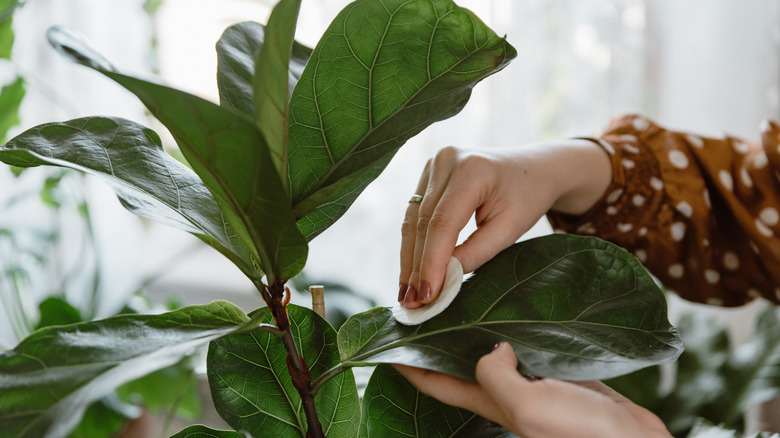Got ants in your … plants? Shaking houseplants is a trend that started, like many obscure-sounding practices, on TikTok. If you haven’t seen videos of people shaking their houseplants by the stem, you might feel shook to find out this is a real thing. But are there really benefits to this viral trend? Believe it or not, there is some evidence to support the practice.
Thigmomorphogenesis, or a plant’s ability to respond to physical stimuli through growth and development, is a complex-sounding term with a simple premise: Touching (that includes shaking!) your plants helps promote their growth. Since physical stimulation is a near-constant reality for vegetation in the wild — from rain, to bugs and animals passing by, to wind, dirt, and other organic debris — certain species have evolved to sense and benefit from physical touch, like shaking.
Gently shaking (emphasis on gentle) your plants, especially species such as fiddle leaf figs, monstera, and rubber trees, can help strengthen their trunks, leaves, immune response, and more. Here’s what you should keep in mind before you shake what Mama Earth gave you.
The science behind the shake
Shake your plants! #hauzplant #shakeplant #plantshakers #plantshaking #ficus #ficusalii #weepingfig #strongroots #indoortree #planttok #tiktokplants #plantsoftiktok #robe #fy #fyp #foryou #foryoupage #relatable #plantcare #plantcaretips #planthacks #haitiantiktok #haiti #tiktokayisyen #trending #viral #plants
♬ original sound – HauzPlant
While it’s definitely not a good idea to violently shake your plants, research supports how occasional, gentle shaking (emphasis on gentle) can initiate an inherent gene response to physical stimuli at a cellular level, activating mechanisms that support cell wall growth, nutrient-sensing, and even immune defense. Thigmomorphogenesis is considered an “adaptive trait associated with increased fitness,” meaning plants that demonstrate this response are poised to survive — and thrive — more than ones without this trait. Shaking your plants is backed by science and has been demonstrated to allow not only healthy growth but also controlled growth. For those who have ever dealt with weirdly bent trunks, stunted leaf growth, or leggy plants straining under their own weight, gentle shaking can help ward off and even retroactively fix these less desirable characteristics.
The serene and quiet demeanor of houseplants, as opposed to the constant and easily noticeable activity of any furry friends we share space with, often makes it easy to forget that our green gods and goddesses are sophisticated, highly attuned beings. Each species, just like every individual human being, has its own unique, specific needs. And anyone who’s ever gone to great and maybe even bizarre (like watering your plants with milk) lengths to keep their finicky Calathea in one piece knows just how fickle some species can be. Enter: the fiddle-leaf fig (Ficus lyrata).
Finicky fiddle-leaf figs love to shake

Fiddle-leaf figs are notoriously fickle, prone to weak trunk growth, and require plenty of light. The good news is these characteristics make it the perfect candidate for shaking. Many fiddle-leaf figs suffer from weak trunks due to a lack of adequate stimuli (wind), which would be omnipresent in their natural environment but is seldom (if ever) a thing when they’re with us indoors. Gently shaking a fiddle-leaf fig back and forth is a simple way to strengthen its trunk. Once or twice daily is sufficient and can lead to long-term results in as little as one growing season.
Does shaking sound like a little too much action? The great news about thigmomorphogenesis is that shaking is only one form of touch that plants benefit from. Misting your plants with a spray bottle and gently wiping off dusty leaves are easy and more laid-back ways to get touchy. The water droplets that run down a plant’s leaves after misting mimic rainfall in the wild, and cleaning off dust will stimulate your plant and keep its leaves primed for photosynthesis. While these varieties of upkeep don’t support the trunk or leaf growth that shaking can result in, they are an easy win for those who are always looking for simple ways to keep their greenery happy and healthy.



